01908 6998020845 899 4400 | 01908 699802Tel 01908 699802
Choosing Welding Gas Regulators


All compressed gases are dangerous, some more than others, so the correctly choosing Welding Gas Regulators is essential.
Gas Regulator Construction
Gas Regulators vary in construction, depending on the gas they’re intended for. Probably the most obvious difference is the screw threads.
Regulators for combustible gases (Acetylene, Propane, Propylene etc), usually have Left Hand Threads. The left hand thread is indicated by little cuts in the flats of the Hexagon.
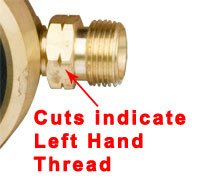
Regulators for non combustible gases (Oxygen, Argon, Co2 etc), usually have Right hand Threads and as such do not have the cuts on the Hexagon.
Another important difference can be the material used to manufacture internal components.
For example, internal Acetylene Regulator components are manufactured from different material to Propane Regulators. It’s therefore important that the correct regulator is used as failure to do so can be extremely dangerous.
In the example outlined above, Propane will corrode the internal components of an Acetylene Regulator, inevitably leading to failure and leaking!
So when choosing welding gas regulators, ALWAYS select the correct regulator for the gas!
Single Stage v Multi Stage Regulators
I’ve written a separate article on the Difference between Single and Multi Stage Regulators
I’ve also produced a Video
Oxygen Gas Regulators
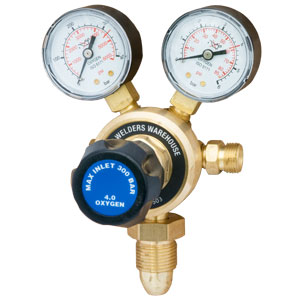
The most common type of Oxygen Regulator has a 0-10 bar outlet. However, as Gas Welding Torches typically only require around 0.2 bar, a Regulator capable of delivering up to 10 bar is going to be difficult to adjust accurately at such a low pressure.
To overcome this, 0-4 bar Oxygen Regulators are also available. These are much easier to adjust at the low pressures required for most Gas Welding & Brazing torches. Even Cutting Guns can be used with nozzles up to 1/16″.
0-10 bar are for where larger Nozzles are going to be used.
I would also recommend not considering an Oxygen or Argon regulator with less than a 300 bar input rating as 300 bar cylinders are becoming more common and are likely to become the norm in future.
Acetylene Gas Regulator
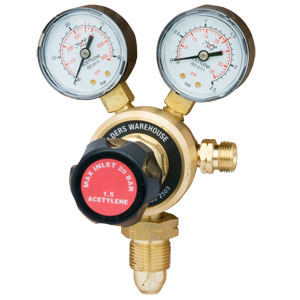
Acetylene becomes unstable and explosive if compressed to a high pressure. Because of this, Acetylene is dissolved in a special material.
Because of the low pressure nature of Acetylene cylinders, the Gas Regulator for Acetylene has a different internal set up.
Most Acetylene Regulators have a maximum delivery pressure of 1.5 bar.
Propane Gas Regulators
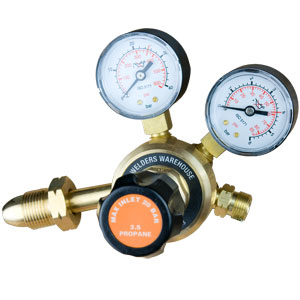
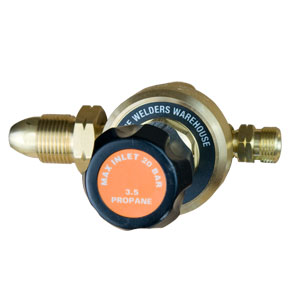
Propane Regulators are commonly supplied with, or without gauges.
As discussed earlier, Acetylene and Propane Regulators should never be used with any other gas than that which they are designed for, although Propane Regulators can be used for Propylene, which is made up of around 50% Propane.
Argon and Argon/Co2 Gas Regulator
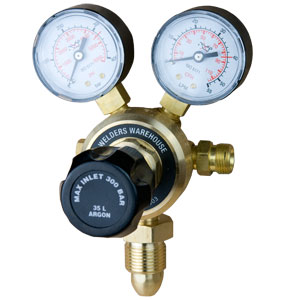
Argon Gas Regulators are much the same as Oxygen Regulators. However, a key thing to look out for is the Delivery Gauge (usually on the Right).
On an Oxygen Regulator the delivery Gauge normally shows Pressure in Psi and Bar. Argon Regulators normally show Gas Flow Rate in Litres Per Minute and Cubic Feet Per Hour.
It’s important to make sure the Delivery Gauge reads Flow Rate as most Mig and Tig Welders will quote a recommended delivery in Litres per Minute.
An Argon Regulator should also be used for Argon/Co2 Mixed gases.
CO2 Gas Regulator
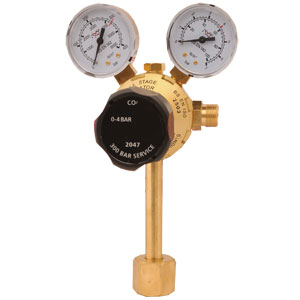
Most of a Co2 Regulator is the same as an Argon Regulator.
The one BIG difference is the Cylinder Fitting, which is Female.
All the other Regulators we have discussed have a Male thread to go into a Female Fitting on the cylinder. Co2 Cylinders have a Male thread, so the Regulator has to have a Female fitting.
Gas Regulators for Disposable Gas Cylinders
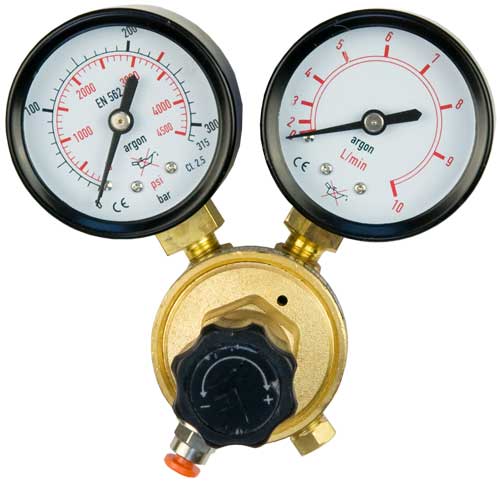
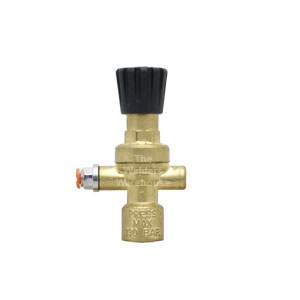
Regulators for Disposable Gas Cylinders do the same job as their refillable cylinder counterparts, except the fitting onto the Cylinder is completely different.
Disposable Cylinders are filled to a lower pressure.
For these reasons, Disposable Cylinder Regulators are not compatible with refillable cylinders.
Regulators for use with Disposable Cylinder can have no Gauges, 1 Gauge or 2 Gauges.
Conclusions
Correctly choosing welding gas regulators is important as pressurised gas cylinders can be dangerous.
But as long as care is taken to choose good quality and the right specification/type for the gas you’re going to be using, all should be well.
I hope you’ve found this article useful, you can find more Gas Equipment related information in our Knowledge Zone and in other articles of my blog.
Please let me know what you thought of this article by leaving a comment. Don’t worry, your email address won’t be added to a database or shared and you won’t receive any unsolicited email.
Cheers
Graham


Hi Graham
I want to know if acytelene gas regulator can still be use as LPG regulator to perform cutting?
Hi Chris
No, LPG will corrode internal parts of an Acetylene Regulator (and vice versa), you need the correct Regulator for the gas type. You need a Propane/LPG Regulator
Hope that helps
Cheers Graham
Hi Graham, I work for a large multi national company involved with many welding operations & processes.
Could you shed any light on set up of a dual gauge regulator set for argon gas tig welder. Whereby the original regular set was removed to undergo maintenance & calibration.
A random replacement regulator with dual gauge very similar was sourced and obtained, however had different gauge increments the replacement flow gauge was in 1000’s whereas the original gauge was in increments of 100’s. Long story short on set up the flow line pressure hose and assembly blew off obviously under extreme pressure.
We assume the wrong regulator gauge set was used as this has never happened before, and we are awaiting re- fit of the original regulator set that has been used for many years. Graham is it possible the regulator set was for another gas process not the argon set that we were administering?
Hi Joe
It sound like the Regulator you bought was not compatible with your existing equipment! (somewhat obvious i know 🙂 )
It’s difficult to be any more specific without seeing the set up and the regulator, which is clearly not possible.
Best course of action would be to contact the supplier of the regulator that has failed and ask them for an explanation.
Sorry I couldn’t help any further.
Regards Graham
I found this information interesting and very useful but I have a question.
I see that some propane regulators do not have gauges fitted to them. Why is this? Are they less necessary for propane than for other gases? How then does a user set them?
Hi Jan
A lot of industrial customers prefer not to have gauges because their operators are careless with equipment and damage them.
The Delivery Pressure Gauge, in my opinion, is important, as accurate setting of pressure can be very important, depending on what you’re doing!
A cylinder contents gauge is less important than for other gases because Propane is stored as a liquid. This liquid turns into vapour inside the cylinder. The pressure of the vapour remains pretty constant until all the liquid has gone, then the pressure drops VERY quickly and the cylinder is empty. So a Contents Gauge will show much the same pressure until the liquid is gone, then the needle will drop VERY quickly as the vapour pressure drops. Where the contents gauge does have some use, is it tells you if the cylinder is empty, or not, but it won’t tell you how much liquid Propane is left.
We wanted a Delivery Pressure Gauge on our Propane Regulators, we were then told that adding a Cylinder Contents Gauge as well would only add a very small amount to the cost of the Regulator. So we felt that for the small extra cost, we may as well have both.
Hope that helps 🙂
Regards
Graham
Good Day
Where in the regulation or rather in which regulation does it state that regulator gauges need to be calibrated and at what intervals…
I’m not aware of any regulation that REQUIRES gauges to be calibrated in the normal course of events.
Where welding is being carried out to a weld procedure and that procedure calls for a specific gas flow rate, then it would be necessary to use calibrated gauges. Calibration would normally need to be carried out annually, unless otherwise specified by the weld procedure.
Cheers Graham
i want to use propane for welding of glass cast iron mold during repair.we use powder spray integrated on the torch for welding.i used propane high pressure regulator Pd=0.2-2 bar
but it could`t develop high pressure that is required to melt the powder.
what can you advise me?
Hi Fikru
It may be that Propane is not hot enough to melt the powder. Also, as it is not possible to successfully weld with Oxygen+Propane because Propane does not provide protection from Oxidisation, it may be the same with powder.
Best I can suggest is speaking with your Powder supplier for more specific advice as they will know what the specific requirements are for the powder you’re using.
Sorry I couldn’t help further.
Cheers Graham
I have emailed twice to your ‘contact us’ address for information to BUY a regulator for a 2.2L disposable oxygen bottle with a 10mm thread, I have received no replies. I am hoping for better luck with this address. I bought from this company some time back a gas welding kit that included Providus bottles and hose with 12mm thread. You no longer sell these bottles and I cannot now connect up my torch to your 2.2L oxy bottles that I have just bought. I did find a valve, Part No D08 that now appears to have disappeared from your site. Tis is what I want if it has the 10mm thread! Please help, Regards Don Clarke
Hi Don
I’ve replied to your emails on the 16th, 19th and 20th of August. These emails were all sent to the email address you’ve used for this comment. Can I suggest having a look in your Spam/Junk file in case my replies have ended up there for some reason!
Failing that, call me (number’s on our website).
I hope that helps.
Cheers Graham
Hi, I’m in a bit of a pickle as I’d like to get your 0-4 bar oxy regulator and an equivalent lpg one for brazing, but I have an American torch(Smith aw1a) and I live in New Zealand. I already have propane specific tips, check valves at torch end and light weight hoses which are all American thread and end in their b size where I need to add flashback arrestors. My problem is that I’ll need some kind of adaptor to go from American b size to then go to flashback arrestors that will work with your regs. Then I think I’ll also need an adaptor to go from your regs to the NZ thread for oxy and propane tanks.
Sorry if this doesn’t make sense.
Thanks.
Hi Christopher
I think I understand what you mean 🤔
Fitting adaptors is not a great way to proceed because every joint is a potential leak!
I am particularly nervous about an adaptor on the high pressure side (cylinder to regulator).
To be honest, I think you would be better off finding regulators that fit your cylinders.
Adaptors on the low pressure side is less worrying, but not ideal, I would consider changing the fitting on the torch to one that fits your equipmment and only resort to adaptors if absolutely necessary.
Sorry it’s perhaps not what you wanted to hear, but I hope it helps.
Kind regards
Graham
Hi, I am a complete novice with regard to gas regulators etc, I have done some oxy/acet welding but it was all set up for me and I didn’t have concern myself with the gauges.
I want to get myself and learn a TIG setup for tubular frame making, I know it’s Argon I will need but I’m not sure about the regulators.
Am I correct in assuming on a twin gauge Argon regulator one is showing cylinder pressure and the other output rate in Ltr/min and that on a single gauge it’s showing cylinder pressure and the output rate is fixed.
If I’m correct in my previous assumption then is it necessary when using a twin gauge regulator to also have a flowmeter on the output. I’m sort of guessing that maybe the output rate control on the regulator isn’t sufficiently precise or maybe I’m missing the point somewhere.
Cheers Ian
Hi Ian
Sorry I’ve not been able to reply sooner. I’m guessing it’s too late now, but our 2 gauge regs show cylinder pressure and delivery flow rate. Our single gauge argon reg shows cylinder pressure, out put is fixed so that a flowmeter will be accurate. Fitting ia flowmeter to an adjustable reg is pointless as it’s unlikely the flowmeter will ever read accurately.
Regards Graham
Thanks,Very concise and informative,Have just left a bid on a couple of brand new old usa made regs with a local auction room.After reading your advice on 300 bar ratings I may still buy them. P.S does anyone have an old flack jacket, best wear one before I crack the valve.
Thanks for the comment, glad you found the article useful.
Have to say that Gas Equipment, especially Regulators is one thing I would definitely not buy old examples of, even if they are allegedly new! Would also be wary of Auction sites for Regulators, however good the deal seems!
If you buy Gas Regulators from a reputable supplier, you can know they’re made to a recognised standard. Such Gas Regulators not expensive and when you consider you’re putting up to 4500 psi of gas pressure into the back of them…………..
What price your life???
Stay Safe
Graham
Hey Graham,
I purchased a LongevityPROMTS 252i multi process welder. When I got it, the regulator appeared to be used and non-functioning. The pop off wasn’t screwed in all the way and the gauge faces look very cheap. Which would you suggest for both MIG & TIG or if I should buy separate, which ones would you recommend. Not welding much over 1/4″ and 1/2″ thickest. I appreciate your paper and assistance. Thanks!
Hi Randy
For the benefit of other readers I would like to point out that we do not supply Longevity welders, so the unit and any substandard/non functioning parts were not supplied by The Welders Warehouse 🙂
Not sure if your UK based, but certainly in the UK, I would suggest a straight forward Argon Regulator as suitable for both Mig and Tig welding, you just need to fit it to the appropriate gas bottle.
Hope this helps
Cheers
Graham
Excellent post helps me in a better way to choose the right welding gas regulators
Good to hear you found the article useful.
Cheers Graham
This is a very helpful article for choosing gas regulators. Thanks for sharing such an informative article.
Thanks for the comment Caleb, glad you found the article useful.
Regards
Graham
Excellent Writeup, Thanks
Thanks Dave, glad you found it useful.
Regards
Graham
Can I use a argon regulator for a pure helium mix?
Hi Mason
Thanks for the question.
The short answer is Yes, as Argon and Helium Regulators are technically the same, apart from labelling.
The longer answer is that we would not recommend it if the Regulator has already been used for Argon, also, as the Argon Regulator is labelled “Argon”, using it for Helium could cause Insurance or Health and Safety issues in the event of any problems.
Hope this helps
Regards Graham
OK…silly me. Didn’t do enough research and saw some regulators at a yard sale. Picked them up and find I have one that is likely Argon and the other Oxygen (I’m pretty sure.) I want to use them for an oxy-acetylene set-up for jewelry making. I looked up the Harris Model # and it said Argon but gauges are marked in psi. The other Victor model is for Oxygen. Lesson learned…do your research first. I had no idea there were so many possibilities!
Hi Kim
I hope the lesson was not too expensive! To be honest, I wouldn’t buy used Regulators as I don’t think the risk is worth it, given the relatively low cost of new. If you consider that an Oxygen cylinder can have over 4000psi of pressure in it, you don’t want a Regulator failing on you with that kind of pressure behind it!!! BCGA (British Compressed Gases Association) recomends routinely replacing Regulators after 5 Years.
Cheers
Graham
Really useful article to help people to have better understanding about gas regulator!
Thanks for the comment Jason, glad you found it useful.
Regards
Graham
Good morning Sir;
I want to know the kinds oxygen CO2 gauge that reduces the flow of air on a patient? I worked at the ELWA Hospital Liberia. Whenever I place oxygen on a patient, it takes 2 to 3 hours and the bottle gets entry. What can I do to reduce flow?
Thanks
Joshua
Hi Joshua
I regret we do not offer Medical Regulators and so could not offer advice for Medical applications. Can I suggest you contact the supplier of your Medical Gas Equipment for advice.
Kind Regards
Graham
My oxygen regulator is broken, and I have just placed an order for the new one.
I have the Ar regulator in my lab. Is it possible to use the Ar regulator for oxygen regulator temporarily?
Thank you.
Some makes of Argon Regulator are exactly the same as Oxygen, other than labelling and calibration of the delivery gauge. In this case, yes you can use an Argon Regulator for Oxygen. BUT, I can only speak for our Regulators, you would need to double check with your Argon Regulators manufacturer to be sure. Did you order the replacement from us? If so it will be on its way and I can check when it will be delivered. Use the Contact Us page of our website to let me know your order ref.
Hope I’ve helped.
Graham
can you tell me what pressure in psi or bar the argon flow rate relates to as I need to have the gauge calibrated.I have a gauge that reads 0-55 litres per minute
Thanks
Thanks for the question Dave
Unfortunately, I don’t know the answer to converting PSI/Bar to Litres per Minute.
There may well be conversion tables Online (try searching), but changing the Regulator for one that does show Gas Pressure rather than Flow is the only sure way of knowing it’s right for the job.
Sorry i couldn’t help further.
Regards Graham
Thanks, great info..was confusing before.
Glad you found it useful – Cheers Graham
Excellent easy to understand information